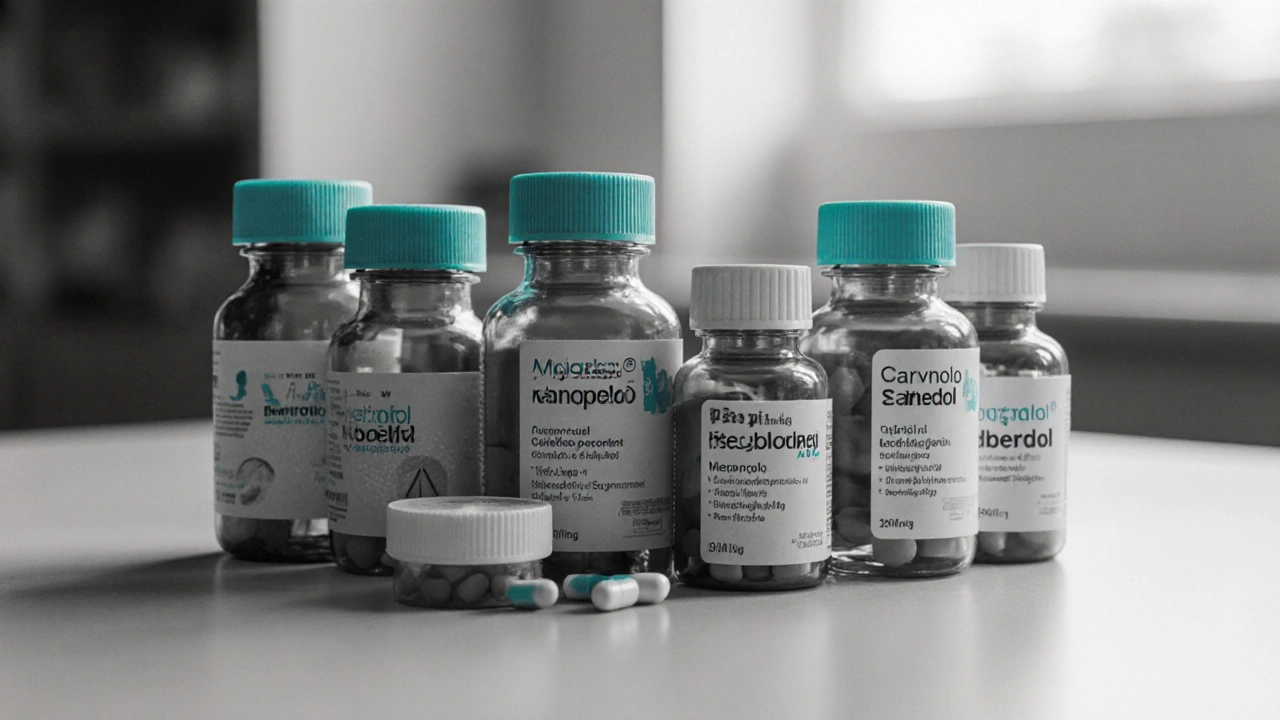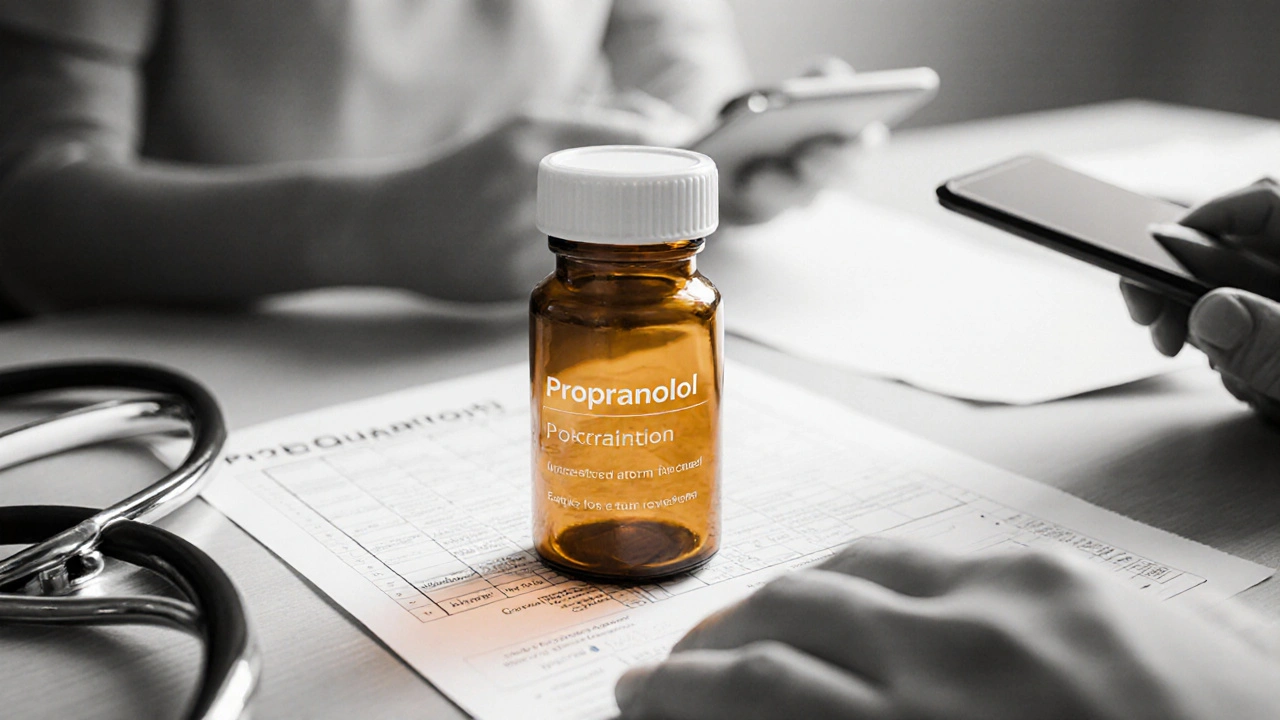Beta-Blocker Selection Tool
Choose Your Conditions
If you're weighing propranolol against other beta‑blockers, you’re probably searching for the drug that fits your health goals without unwanted side effects. Below you’ll find a deep dive into how propranolol works, where it shines, and how it measures up to the most common alternatives.
Propranolol is a non‑selective beta‑adrenergic blocker that was first approved by the FDA in 1964. It blocks both β1 and β2 receptors, lowering heart rate, reducing cardiac output, and dampening the body’s response to adrenaline. Typical oral doses range from 40mg to 320mg per day, split into two or three doses, and the drug’s half‑life sits around 3-6hours, requiring multiple daily administrations for steady blood levels.
How Propranolol Works
By inhibiting β1 receptors in the heart, propranolol reduces the force of contraction and slows the sinus node, which leads to lower blood pressure and fewer arrhythmic beats. Its β2 blockade also blunts tremor and anxiety symptoms, making it popular for migraine prophylaxis. Because it affects both receptor subtypes, it can be useful for patients who need broader control, such as those with concurrent hypertension and anxiety.
Key Clinical Uses
- Hypertension (high blood pressure)
- Angina pectoris (chest pain due to reduced blood flow)
- Arrhythmias, especially ventricular ectopic beats
- Myocardial infarction (post‑heart‑attack management)
- Migraine prevention
- Essential tremor and performance anxiety
Common Side Effects and Precautions
Because propranolol blocks β2 receptors in the lungs, it can worsen asthma or chronic obstructive pulmonary disease (COPD). Other frequent side effects include fatigue, cold extremities, and occasionally depressive mood. Patients with severe bradycardia (<60bpm) or heart block should avoid the drug unless a cardiologist supervises the regimen.

Alternative Beta‑Blockers to Consider
When propranolol isn’t a perfect fit, clinicians often turn to more selective or combined agents. Below are the most widely used alternatives:
Metoprolol is a β1‑selective blocker that primarily targets the heart while sparing the lungs. It’s a go‑to choice for patients with asthma who still need heart‑rate control. Typical doses range from 50mg to 200mg daily, with a half‑life of 3-7hours.
Atenolol is another β1‑selective blocker notable for its hydrophilic nature, which limits central nervous system penetration. This reduces the risk of depression and sleep disturbances. Doses usually sit between 25mg and 100mg per day, and the half‑life extends to 6-9hours.
Carvedilol combines non‑selective β‑blockade with α1‑adrenergic antagonism. The added α1 effect promotes vasodilation, making it especially helpful in heart‑failure patients. Starting doses are low (6.25mg twice daily) because of its potent blood‑pressure‑lowering effect, and the half‑life averages 7-10hours.
Labetalol is a mixed α/β blocker that can be given orally or intravenously. It’s frequently used in hypertensive emergencies and during pregnancy because it provides rapid blood‑pressure control without excessive heart‑rate reduction. Oral doses start at 100mg twice daily; its half‑life is about 5-8hours.
Timolol is a non‑selective β‑blocker primarily supplied as an eye drop for glaucoma, but systemic absorption can affect heart rate. Oral timolol is rarely used, but it illustrates how beta‑blockade can be leveraged in ophthalmology.
Side‑by‑Side Comparison
| Drug | Selectivity | Common Uses | Typical Dose Range | Half‑life | Notable Side Effects |
|---|---|---|---|---|---|
| Propranolol | Non‑selective (β1&β2) | Hypertension, angina, arrhythmia, migraine, tremor | 40-320mg/day | 3-6h | Bronchospasm, fatigue, depression |
| Metoprolol | β1‑selective | Hypertension, heart‑failure, post‑MI | 50-200mg/day | 3-7h | Bradycardia, mild bronchoconstriction |
| Atenolol | β1‑selective (hydrophilic) | Hypertension, angina | 25-100mg/day | 6-9h | Cold extremities, insomnia (rare) |
| Carvedilol | Non‑selective β + α1 | Heart‑failure, hypertension | 6.25-50mgbid | 7-10h | Dizziness, weight gain |
| Labetalol | Non‑selective β + α1 | Hypertensive emergencies, pregnancy | 100mgbid | 5-8h | Hypotension, liver enzyme rise |
| Timolol | Non‑selective β | Glaucoma (ophthalmic), occasional systemic use | 0.5% eye drops; oral rare | 5-6h | Bronchospasm, bradycardia (systemic) |
When to Choose Propranolol Over the Rest
- Broad receptor coverage needed: Patients with both cardiac and anxiety‑related symptoms often benefit from the dual β1/β2 blockade.
- Migraine prevention: Propranolol has the strongest evidence among beta‑blockers for reducing migraine frequency.
- Cost sensitivity: As an older generic, propranolol is usually cheaper than newer agents like carvedilol.

When an Alternative Might Be a Better Fit
- Respiratory disease: Choose a β1‑selective agent such as metoprolol or atenolol to avoid bronchospasm.
- Heart‑failure with reduced ejection fraction: Carvedilol or labetalol’s α1 activity improves after‑load reduction.
- Pregnancy: Labetalol is often preferred because it’s been studied more extensively in pregnant patients.
- Need for once‑daily dosing: Some formulations of atenolol or extended‑release metoprolol can simplify regimens.
Quick Checklist for Clinicians and Patients
- Confirm indication (e.g., hypertension vs. migraine).
- Screen for asthma, COPD, or severe bradycardia.
- Review current meds for potential β‑blocker interactions (e.g., calcium‑channel blockers).
- Pick the drug that matches receptor selectivity to the patient’s comorbidities.
- Start low, titrate slowly, and monitor heart rate and blood pressure.
Frequently Asked Questions
What conditions is propranolol best for?
Propranolol shines in hypertension, angina, various arrhythmias, post‑myocardial infarction care, migraine prophylaxis, essential tremor, and performance anxiety.
Can I take propranolol if I have asthma?
Because propranolol blocks β2 receptors in the lungs, it can trigger bronchospasm. Patients with moderate‑to‑severe asthma should use a β1‑selective blocker instead, or discuss alternatives with their doctor.
How does carvedilol differ from propranolol?
Carvedilol adds α1‑adrenergic blockade, which causes vasodilation. This makes it especially useful in heart‑failure where after‑load reduction is beneficial, whereas propranolol lacks the α1 effect.
Is propranolol safe during pregnancy?
Propranolol is Category C; animal studies have shown risk, but limited human data exist. Labetalol is generally preferred for hypertension in pregnancy.
What are the common side effects I should watch for?
Typical complaints include fatigue, cold hands or feet, mild dizziness, and occasional depressive mood. Serious warnings are bronchospasm, severe bradycardia, or heart block.
Understanding the nuances of each beta‑blocker lets you or your clinician pick the right tool for the job. Whether you need broad‑spectrum control, lung‑friendly selectivity, or added vasodilation, the table and checklist above should make the decision clearer.





One comment
Propranolol is the blunt oxcart for the heart, and anyone using it should know it can kill your stamina.
When you compare a non‑selective beta‑blocker to its more selective cousins, you’re not just weighing efficacy, you’re weighing the very philosophy of how we tame the autonomic storm. Propranolol, born in the era of analog watches, still carries the gravitas of a classic novel – dense, unapologetic, and occasionally misunderstood. Its capacity to quiet tremor and anxiety feels like a quiet prayer in a noisy cathedral. Yet, the very breadth that makes it versatile also invites a cascade of side‑effects that can feel like the shadow of an ancient deity. In short, it’s a drug that deserves the same reverence we give to an old master’s painting.
Propranolol works by blocking both β1 and β2 receptors, which lowers heart rate and reduces the fight‑or‑flight surge of adrenaline. This makes it useful for hypertension, arrhythmias, and even performance anxiety. Remember to watch for bronchospasm in asthmatic patients – the β2 block can be a problem. Dose titration is key; start low and go slow to avoid excessive fatigue. If you have COPD, discuss alternatives with your doctor.
What Karen paints as philosophical nuance is, in practice, a double‑edged sword. The same β2 blockade that eases tremor also constricts bronchi, turning a calm heart into a potential respiratory nightmare for asthma sufferers. Moreover, the half‑life of 3‑6 hours forces multiple daily doses, which can be a compliance nightmare for busy lives. In the grand theatre of cardiovascular drugs, propranolol takes the role of the seasoned veteran, but the script demands careful direction. For migraine prophylaxis it shines, yet for pure hypertension a cardio‑selective agent might be a smoother lead.
Short note: propranolol can blunt exercise capacity.
From a cultural standpoint, propranolol’s long history reflects how medicine evolves with societal needs. Its role in treating anxiety during public speaking mirrors the human desire to control visible vulnerability. While it remains a staple, emerging therapies are beginning to offer more targeted solutions, especially for patients wary of systemic side effects. It’s worth considering lifestyle adjustments alongside pharmacology when tackling performance anxiety.
Adding to Sharon’s point, it’s important to note that propranolol can interact with other medications metabolized by CYP2D6. This includes certain antidepressants and anti‑arrhythmics, which may raise plasma levels and increase adverse effects. Monitoring blood pressure and heart rate regularly is prudent, especially when starting or adjusting dosages. Also, patients with diabetes should be aware that propranolol can mask hypoglycemia symptoms.
I’ve seen many patients switch to bisoprolol for pure blood‑pressure control, and they love the once‑daily dosing. Propranolol’s frequent dosing can be a hassle, but its ability to manage tremor still makes it unique. If you’re not dealing with asthma or COPD, it’s still a solid choice for many indications.
From a pharmacokinetic perspective, propranolol’s lipophilicity permits crossing the blood‑brain barrier, which is a double‑sided sword. It contributes to central anxiety reduction but also to CNS side effects like vivid dreams or depression. In clinical practice, we weigh this BBB penetration against therapeutic gains. For patients with migraine prophylaxis, the central action is beneficial, whereas for pure cardiac indications, a more hydrophilic beta‑blocker like atenolol could be preferable to minimize CNS exposure.
Patriotic note: American doctors love propranolol because it’s made domestically and has stood the test of time. It’s a home‑grown hero that fights both heart attacks and the stress of modern life.
Whoa hold up - all this love‑fest for propranolol is totally missing the point. First of all, it’s not the only game‑in‑town, yet everyone acts like it’s the holy grail of beta‑blockers, which is just plain wrong. Second, the side‑effects? Yeah, they’re real, but nobody mentions how it can absolutely wreck your sleep cycles, and don’t even get me started on the mood swings that can come out of nowhere. Third, the dosage regimen is a nightmare for anyone who’s trying to keep a normal life, it’s like you have to set alarms every few hours just to stay on schedule. Fourth, let’s talk about the cost – the generic is cheap, but the brand name blows a hole in your wallet if you’re not careful. Fifth, the interaction chart is a labyrinth; mix it with antidepressants and you’re basically signing up for a cardiac roller coaster. Sixth, why are we still prescribing something that was discovered in the sixties when newer agents have better selectivity and fewer pulmonary issues? Seventh, people with asthma get a raw deal, yet the guidelines still push propranolol onto them like it’s a one‑size‑fits‑all. Eighth, the whole “it helps with performance anxiety” line is a myth – it only masks symptoms, it doesn’t fix the underlying issue. Ninth, for migraine prevention you might as well try a CGRP inhibitor because it’s proven to be more effective. Tenth, the drug can cause cold extremities that make you look like a walking icicle in winter, which is just embarrassing. Eleventh, the fatigue you feel isn’t just a mild side effect, it’s a full‑blown crash that can affect your work and daily activities. Twelfth, the depression risk is not just a footnote; it can be severe enough to need a therapist. Thirteenth, the lack of patient education is shocking – most don’t know why they’re on it or what to watch for. Fourteenth, the endless need for monitoring appointments adds up to a huge time sink. Fifteenth, at the end of the day, propranolol is a relic, and we should be moving forward, not clinging to outdated meds when better options exist.